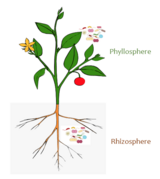| Part of a series on |
| Microbiomes |
|---|
 |
In plant science, the spermosphere is the zone in the soil surrounding a germinating seed.[1] The zone is a small area, typically 1–10 mm from the seed, but varying with seed type, the variety of soil microorganisms, the level of soil moisture, and other factors.[2] Within the spermosphere, a range of complex interactions take place among the germinating seed, the soil, and the microbiome.[3][1] Because germination is a brief process, the spermosphere is transient, but the impact of the microbial activity within the spermosphere can have strong and long-lasting effects on the developing plant.[3]
Seeds exude various molecules that influence their surrounding microbial communities, either inhibiting or stimulating their growth.[1][3] The composition of the exudates varies according to the plant type and such properties of the soil as its pH and moisture content. With these biochemical effects, the spermosphere develops both downward—to form the rhizosphere (upon the emergence of the plant's radicle)[3]—and upward to form the laimosphere, which is the soil surrounding the growing plant stem.
References
- ^ a b c Nelson, Eric B. (2004). "Microbial dynamics and interactions in the spermosphere". Annual Review of Phytopathology. 42: 271–309. doi:10.1146/annurev.phyto.42.121603.131041. PMID 15283668.
- ^ Beattie, Gwyn A. (2006). "Plant-Associated Bacteria: Survey, Molecular Phylogeny, Genomics and Recent Advances". In Gnanamanickam, Samuel S. (ed.). Plant-associated bacteria. Vol. 1. Springer Publishing. p. 2. doi:10.1007/978-1-4020-4538-7_1. ISBN 978-1-4020-4538-7.
- ^ a b c d Schiltz, S; Gaillard, I; Pawlicki-Jullian, N; Thiombiano, B; Mesnard, F; Gontier, E (December 2015). "A review: what is the spermosphere and how can it be studied?". Journal of Applied Microbiology. 119 (6): 1467–81. doi:10.1111/jam.12946. PMID 26332271.
